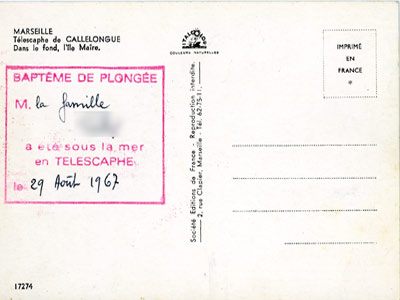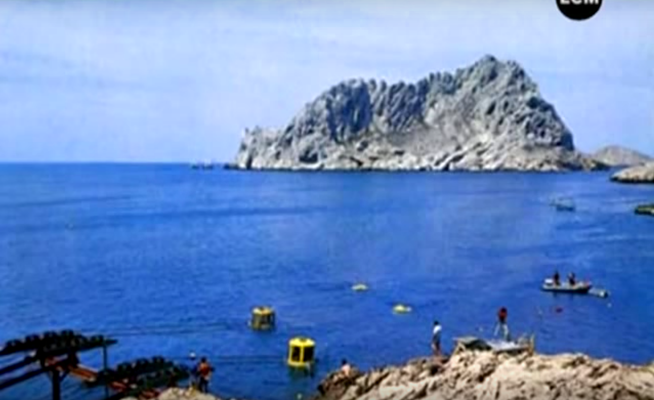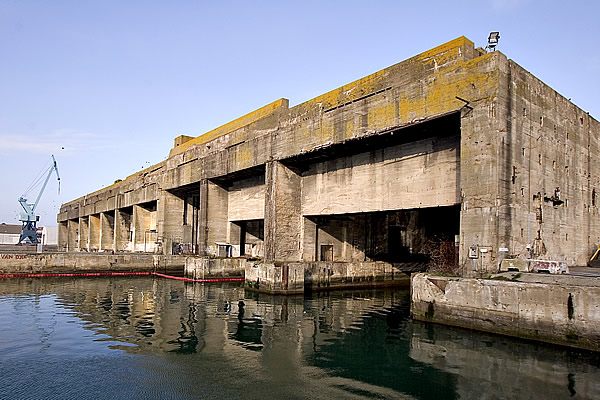About
The late 1960s in France was a heady time. The country was emerging after WWII as an economic force and the world's fourth nuclear power. Sexual and cultural revolution swept across the country as it did across the rest of the Western world. It was a time of idealism and whimsy, of freedom and excitement. Anything was possible.
This was the background against which James Couttet, a world famous French skier, and Denis Creissels, an engineer, set out to build Le Téléscaphe. As the skier and the engineer began talking, they mused, if anything was possible, why were there no ski lifts underwater? Why not build a Jules Verne-inspired set of submarine cars pulled by a massive cable that could take riders ten meters underwater and pull them across the ocean from one small fishing village to another. Amazingly, they built just that on the coast of Marseille.
In 1966, for twelve francs, you and up to six friends could squeeze into a small yellow capsule fitted with windows on the sides and top and be dropped into the water. The capsule would then be lowered some ten meters down onto a set of cables where you would be pulled across the ocean between Goudes and Callelongue. The underwater journey was for a distance of around half a kilometer. Lest you be terrified of something going wrong in this small capsule that was now deep under the water–a crack in the glass, being carried out into the ocean, a sudden depressurization, running out of air–the tiny submarines were always escorted by divers on their journey. The capsules even had lights and could be run at night.
After a ten minute underwater journey (and a pleasurable mix of wonder and terror), riders completed their ride on Le Téléscaphe and were hauled up on the other side to receive their certificate of "diving baptism" or baptême de plongée. From 1966 to 1967 over 31,000 people took this underwater journey.
While popular, the submarine experience was not without problems. With technical upkeep and divers to pay, it was wildly expensive to run. There were also... some incidents. One of the capsules ended up on its side and a French couple and their two children had to escape the tiny submarine and complete their journey via terrified swim.
After only a single year of operation the dream of an underwater ski lift was over. Despite having sunk over two million francs in the project, Le Téléscaphe was closed. Today all that remains of Le Téléscaphe are the huge mechanical wheels that were used to pull the underwater cables and the memories of a handful of people who took that magical underwater journey.
Related Tags
Know Before You Go
You can find one of these remnants below the road, at the last bend before arriving in Callelongue. The other (from the other end of the cableway) is harder to find.
Published
May 20, 2016
Sources
- https://www.allboatsavenue.com/revivez-lexploration-eaux-calanque-callelonguea-marseille-celebre-telepherique-marin/
- http://madeinmarseille.net/13333-telescaphe-plongee-tourisme-sous-marin/
- https://www.allboatsavenue.com/revivez-lexploration-eaux-calanque-callelonguea-marseille-celebre-telepherique-marin/
- https://translate.google.com/translate?hl=en&sl=fr&u=https://fr.wikipedia.org/wiki/T%25C3%25A9l%25C3%25A9scaphe&prev=search
- http://www.vieux-marseille.com/pages/telescaphe/telescaphe2.htm
- https://www.ina.fr/video/CPF04006345
- http://www.ina.fr/video/RAF03025671
- http://tools.wmflabs.org/geohack/geohack.php?language=fr&pagename=T%C3%A9l%C3%A9scaphe¶ms=43.21135_N_5.35064_E_



































































